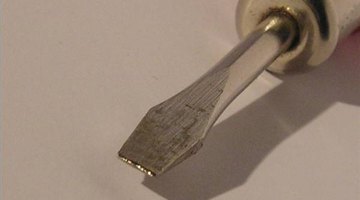How to Test if an Upper or Lower Thermostat Is Bad
A thermostat is a control device that acts like a switch, turning something on and off based on the temperature of the thermostat control element. A water heater uses two thermostats to control the heaters in the tank.

There are an upper thermostat and a lower thermostat that are usually pressed against the sides of the tank and covered with protective plates. Both thermostats monitor the water temperature, but one monitors the temperature high in the tank, and the other element monitors it low in the tank. Because heat rises, the upper thermostat is the controlling thermostat for power to the lower thermostat. When the upper part of the water tank gets hot and trips the thermostat, it sends power to the lower thermostat so it can turn on the lower heater.
-
Use caution when working with these voltages. Because you need to measure the voltages present at the thermostats, this troubleshooting must be performed with power applied to the water heater. See if there is any hot water available from a household faucet. Keep this in mind because it will affect a later step.
-
Gain access to the water heater. Use a screwdriver to remove the plates that cover the thermostat controls for the water heater. There should be one on the upper half of the water heater and one on the lower half.
-
Check the voltage with a voltmeter at the upper heating element if there was no hot water available from the household faucet. If there is no hot water, there should be voltage present at the upper heating element, either 120 or 240 volts, depending on your house wiring and water heater model. If there is no voltage and there is no hot water, the upper thermostat is faulty.
-
Measure the voltage from the upper thermostat terminals that send wires to the lower thermostat assembly. There should be a voltage present if there is some amount of hot water available from the household faucet and the problem is insufficient hot water. If there is no voltage present, the upper thermostat is faulty.
-
Move to the lower thermostat and measure the voltage across the heating element. If the problem is insufficient hot water, there should be a voltage present, 120 or 240, at the lower heater element. If there is no voltage present, the lower thermostat is defective.
Things You Will Need
- Voltmeter
- Screwdriver
Tip
If your water heater is in a crawl space without a lot of room, wear knee pads to protect your knees from scraping on the ground.
Warning
The voltage going to a water heater is dangerous and can cause electrical shock.
Writer Bio
Doug Hewitt has been writing for over 20 years and has a Master of Arts from University of North Carolina-Greensboro. He authored the book "The Practical Guide to Weekend Parenting," which includes health and fitness hints for parents. He and his wife, Robin, are coauthors of the "Free College Resource Book."
Photo Credits
- morguefile
- morguefile
More Articles



